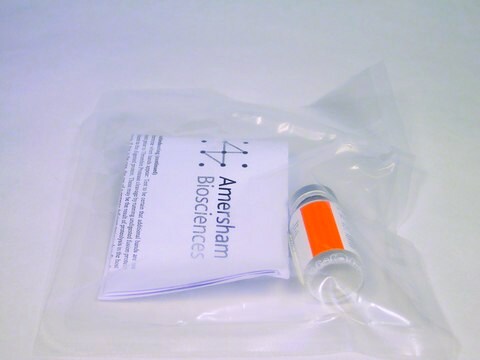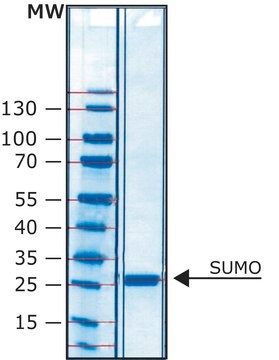Wszystkie zdjęcia(1)
Kluczowe dokumenty
GS59
GST M5-5, rekombinowany ludzki
Synonim(y):
S-transferaza glutationowa mu 5
Zaloguj sięWyświetlanie cen organizacyjnych i kontraktowych
About This Item
Kod UNSPSC:
12352200
NACRES:
NA.55
Polecane produkty
pochodzenie biologiczne
human
Poziom jakości
rekombinowane
expressed in E. coli
Próba
>95% (SDS-PAGE)
Formularz
frozen liquid
aktywność właściwa
183.9 units/mg protein
masa cząsteczkowa
27.4 kDa
stężenie
3.2 mg/mL
temp. przechowywania
−70°C
informacje o genach
human ... GSTM5(2949)
Opis ogólny
za pomocą spektrofotometrycznego oznaczania koniugacji 1-chloro-2,4-dinitrobenzenu (CDNB) ze zredukowanym glutationem (1 mM) w 100 mM NaPO4 (pH 6,5) w temperaturze pokojowej.
Działania biochem./fizjol.
Gen GSTM5 koduje S-transferazę glutationu należącą do klasy mu. Enzymy klasy mu funkcjonują w detoksykacji związków elektrofilowych, w tym czynników rakotwórczych, leków terapeutycznych, toksyn środowiskowych i produktów stresu oksydacyjnego, poprzez koniugację z glutationem. Geny kodujące enzymy klasy mu są zorganizowane w klaster genów na chromosomie 1p13.3 i wiadomo, że są wysoce polimorficzne. Te warianty genetyczne mogą zmieniać indywidualną podatność na czynniki rakotwórcze i toksyny, a także wpływać na toksyczność i skuteczność niektórych leków. Dywersyfikacja tych genów nastąpiła w regionach kodujących domeny wiążące substraty, a także we wzorcach ekspresji tkanek, aby dostosować się do rosnącej liczby obcych związków.
S-transferaza glutationowa mu 5 (GSTM5) to enzym, który u ludzi jest kodowany przez gen GSTM5. S-transferazy glutationowe (GST) to rodzina enzymów, które odgrywają ważną rolę w detoksykacji poprzez katalizowanie koniugacji wielu hydrofobowych i elektrofilowych związków ze zredukowanym glutationem. W oparciu o ich właściwości biochemiczne, immunologiczne i strukturalne, cytozolowe i związane z błoną formy S-transferazy glutationu są kodowane przez dwie różne rodziny supergenów. Obecnie zidentyfikowano osiem różnych klas rozpuszczalnych cytoplazmatycznych S-transferaz glutationowych ssaków: alfa, kappa, mu, omega, pi, sigma, theta i zeta. Uważa się, że GST funkcjonują w metabolizmie ksenobiotyków i odgrywają rolę w podatności na raka i inne choroby.
Przechowywanie i stabilność
Enzym powinien zostać wykorzystany przez użytkownika końcowego w ciągu 1 roku od jego otrzymania.
Ta strona może zawierać tekst przetłumaczony maszynowo.
Kod klasy składowania
10 - Combustible liquids
Klasa zagrożenia wodnego (WGK)
WGK 1
Temperatura zapłonu (°F)
Not applicable
Temperatura zapłonu (°C)
Not applicable
Wybierz jedną z najnowszych wersji:
Certyfikaty analizy (CoA)
Lot/Batch Number
Nie widzisz odpowiedniej wersji?
Jeśli potrzebujesz konkretnej wersji, możesz wyszukać konkretny certyfikat według numeru partii lub serii.
Masz już ten produkt?
Dokumenty związane z niedawno zakupionymi produktami zostały zamieszczone w Bibliotece dokumentów.
Variation in the GST mu locus and tobacco smoke exposure as determinants of childhood lung function.
Carrie V Breton et al.
American journal of respiratory and critical care medicine, 179(7), 601-607 (2009-01-20)
The glutathione S-transferases (GSTs) are important detoxification enzymes. To investigate effects of variants in GST mu genes on lung function and assess their interactions with tobacco smoke exposure. In this prospective study, 14,836 lung function measurements were collected from 2,108
Y V Patskovsky et al.
Biochemistry, 38(49), 16187-16194 (1999-12-10)
The hGSTM3 subunit, which is preferentially expressed in germ-line cells, has the greatest sequence divergence among the human mu class glutathione S-transferases. To determine a structural basis for the catalytic differences between hGSTM3-3 and other mu class enzymes, chimeric proteins
Ying Wang et al.
Journal of human genetics, 55(8), 490-494 (2010-05-21)
Coronary atherosclerosis is a complex and progressive condition that involves many biological pathways, including the oxidative stress and inflammatory response pathways. To investigate the association between common genetic variation within these two pathways and coronary atherosclerosis, we performed a comprehensive
Christian Delles et al.
Journal of hypertension, 26(7), 1343-1352 (2008-06-14)
Glutathione S-transferases are involved in defences against oxidative stress. We have recently demonstrated reduced expression of glutathione S-transferase mu type 1 (Gstm1) in a rat model of hypertension. Here, we examine the association between GSTM variants and hypertension in human.
Ann M Moyer et al.
Cancer epidemiology, biomarkers & prevention : a publication of the American Association for Cancer Research, cosponsored by the American Society of Preventive Oncology, 19(3), 811-821 (2010-03-05)
Lung cancer is commonly treated with platinum compounds. The "glutathione pathway" participates in the metabolism of platinum compounds. We set out to test the hypotheses that single nucleotide polymorphisms (SNPs) or copy number polymorphisms for genes within the glutathione pathway
Nasz zespół naukowców ma doświadczenie we wszystkich obszarach badań, w tym w naukach przyrodniczych, materiałoznawstwie, syntezie chemicznej, chromatografii, analityce i wielu innych dziedzinach.
Skontaktuj się z zespołem ds. pomocy technicznej








